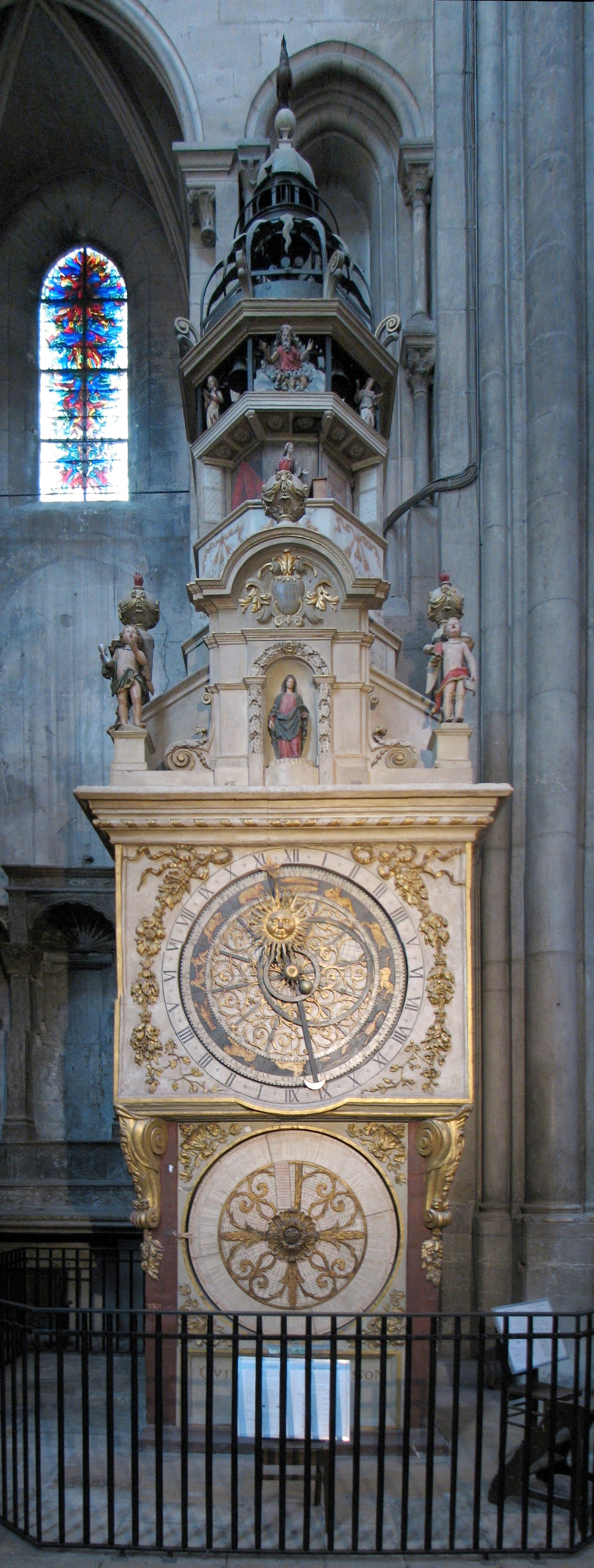

When I was a child, I was fascinated by cuckoo clocks. One of my aunts had one, and whenever we visited, I would sit there, waiting for the hour to strike so that the little bird would pop out and do its chirping.
There are less purely cheerful animated clocks, of course. Not long ago, Sotheby’s had an erotic 18th century clock. It looked quite innocent—the naughty bits were hidden behind a painting of a duck. (Don’t get your hopes up. It was more ludicrously comic than erotic.)
A bit earlier, medieval and renaissance craftsmen created elaborate automatons and astronomical clocks for public buildings. There is the 15th century astronomical clock in Prague, where Death strikes the hours while the twelve apostles circle. It is accompanied by a grisly legend. At least I hope the story is apocryphal.
The 16th century town clock in Munich is a much more cheerful affair, featuring jousters and dancers and beer barrels. (It is Munich, after all.)
When I was researching the route my characters in Lady Elinor’s Wicked Adventures would take to get to Rome, it seemed likely that they would go through Lyon. And Lyon, I discovered, has a marvelous astronomical clock that includes a perpetual calendar, the phases of the moon and all kinds of wonders. So I put it in the book:
By pure chance, they arrived at the cathedral just before the clock struck noon, unaware that the clock was one of the wonders of the town. It was an astronomical clock, some thirty feet high. When the noon hour struck, a rooster atop the edifice beat its wings, raised its head, and crowed three times. An angel with an hourglass turned it over while other angels played a hymn on the bells. In a small oratory, a dove descended while the Angel Gabriel appeared to Mary for the Annunciation.
The first bell caught their attention and they watched in fascination. Lady Elinor darted around the clock to try to see all its wonders. The sacristan, a little gnome of a man in a dusty cassock, was delighted by the attention and gladly began answering all the questions that were thrown at him.
Charles Dickens was less enthusiastic when he visited Lyon. In fact, he was downright grumpy. He considered Lyon to combine the worst of every dirty foreign town with the worst of every grimy manufacturing town and hoped to never see it again. Perhaps that grumpiness explains why he was not impressed by the clock. He described it in Pictures from Italy:
The keeper of the church was very anxious it should be shown; partly for the honour of the establishment and the town; and partly, perhaps, because of his deriving a per-centage from the additional consideration. However, that may be, it was set in motion, and thereupon a host of little doors flew open, and innumerable little figures staggered out of them, and jerked themselves back again, with that special unsteadiness of purpose, and hitching in the gait, which usually attaches to figures that are moved by clock-work.
Meanwhile, the Sacristan stood explaining these wonders, and pointing them out, severally, with a wand. There was a centre puppet of the Virgin Mary; and close to her, a small pigeon-hole, out of which another and a very ill-looking puppet made one of the most sudden plunges I ever saw accomplished: instantly flopping back again at sight of her, and banging his little door, violently, after him.
Taking this to be emblematic of the victory over Sin and Death, and not at all unwilling to show that I perfectly understood the subject, in anticipation of the showman, I rashly said, “Aha! The Evil Spirit. To be sure. He is very soon disposed of.” “Pardon, Monsieur,” said the Sacristan, with a polite motion of his hand toward the little door, as if introducing somebody—“The Angel Gabriel!”
At least I hope it was only grumpiness, or perhaps dyspepsia, that made him unable to enjoy such a delightful automaton.
|

Comments
How fun! I love your
How fun! I love your description of the clock in Lady Elinor much better than the one from Dickens. I can feel her enthusiasm as she discovers its secrets. For Dickens, I felt only his... confusion? I can almost picture him jumping back in uncomfortable surprise as all the little wonders appeared. Though Dickens did have a way of seeing the darker, dirtier side of things... and life... didn't he? Still, I think it would be amazing to see these clocks in person.
Awesome perspective about clocks
There's no doubt that you have an interesting point of view about clocks. Some people just disregard the essence of time entirely and they don't make every second of it count. I hope that people will stumble upon your article so that they can reflect on the time that they have.
Post new comment